Cataract Surgery
Cataract is a disease in which the crystalline lens becomes cloudy and vision deteriorates.
Cataracts are classified into several types depending on the cause of their onset, but the majority of presbycusis is age-related, in which the crystalline lens becomes cloudy with age and vision deteriorates. The crystalline lens acts like a camera lens in the eye and has the function of focusing the light coming in from the outside on the retina. Originally it is a transparent tissue, but cataract is a disease in which the crystalline lens, which plays the role of this lens, becomes cloudy. When the crystalline lens becomes cloudy, light cannot reach the retina, causing symptoms such as glare and poor vision. In the case of presbycusis, the turbidity begins around the crystalline lens and gradually progresses toward the center. Therefore, in the early stages of cataract, there are few subjective symptoms, but as the cataract progresses, the subjective symptoms gradually appear.
-
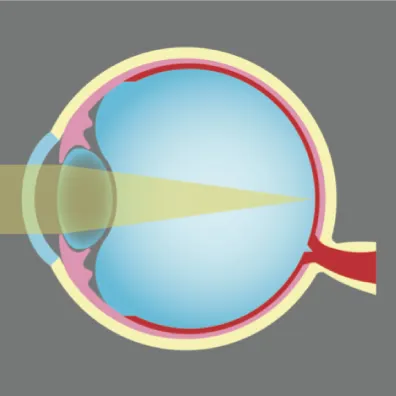
A normal crystalline lens can deliver light to the retina.
-
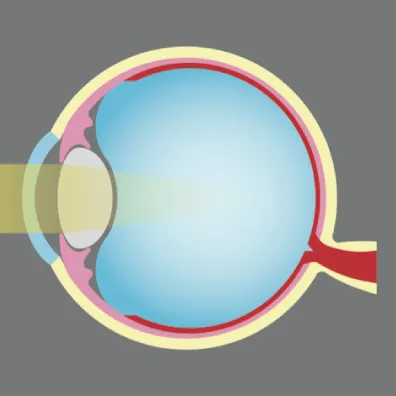
When the crystalline lens becomes cloudy due to cataract, light cannot reach the retina.
When the crystalline lens becomes cloudy due to cataracts, it has various effects on vision.In cataracts caused by aging, turbidity develops from around the crystalline lens and gradually progresses toward the center. Therefore, there are no noticeable subjective symptoms in the early days, but when the turbidity reaches the center, symptoms such as haze of the eyes and decreased vision appear.
How it looks due to cataracts
-

Normal visibility
-

ILooks white and hazy due to cataracts
Main symptoms of cataract
- The field of vision becomes hazy
- The light is dazzling
- Visual acuity deteriorates
- The appearance of dark and bright places is different
The main causes of cataracts
When the crystalline lens becomes cloudy due to cataracts, it has various effects on vision.In cataracts caused by aging, turbidity develops from around the crystalline lens and gradually progresses toward the center. Therefore, there are no noticeable subjective symptoms in the early days, but when the turbidity reaches the center, symptoms such as haze of the eyes and decreased vision appear.
Age-related cataract
Age-related cataracts are caused by changes in the proteins that make up the crystalline lens due to prolonged exposure to UV light. Cataracts begin to appear in most people over the age of 70 and are said to be one of the aging phenomena of the eyes.Traumatic cataract
Traumatic cataracts are caused by a strong impact on the eye or damage to the crystalline lens due to intraocular surgery. Causes include impact on the eyes in martial arts and ball games, and stabs in metal pieces. Depending on the damaged area, symptoms may not appear immediately or may occur years later.Comorbid cataract
Comorbid cataracts are cataracts that accompany other eye diseases. Typical diseases include uveitis, glaucoma, retinal detachment, retinitis pigmentosa, and endophthalmitis.Congenital cataract
Congenital cataracts are cataracts in which the crystalline lens is naturally cloudy. The main cause is said to be if the mother suffers from rubella during pregnancy or due to genetic factors. The crystalline lens may be cloudy from birth, or it may develop as it grows. Congenital cataracts also affect the formation of visual acuity, so early detection and treatment are important.Atopic cataract
Atopic cataracts are said to be caused by immune disorders of the proteins that make up the crystalline lens and irritation to the crystalline lens by rubbing or tapping against itching. Approximately 30% of people who develop atopic dermatitis also have cataracts, and those who have atopic symptoms on the face or who have been treated for atopic dermatitis for a long time are at risk of developing cataracts. It tends to be higher.Diabetic catarac
Diabetic cataracts are divided into “true diabetic cataracts” caused by prolonged hyperglycemic conditions due to diabetes and “pseudodiabetic cataracts” that occur in combination with general age-related cataracts. In diabetes, not only glucose in the blood but also glucose concentration in the crystal body becomes high, and sorbidol, a substance that is unnecessary for the body, is produced in the crystal body. It is believed that this sorbidol causes the crystalline lens to become cloudy. Diabetic cataracts develop even in young people and are characterized by rapid progression.Drug-induced cataract
Drug-induced cataracts are cataracts that develop as a side effect of long-term use of steroids. It is said that pilocarpine, an eye drop used to treat glaucoma, can also cause cataracts. If you stop using the drug early, the opacity of the crystalline lens may improve.Cataract treatment
In the early stages of cataracts, medications can slow the progression, but surgery is the only cure for cataracts, as there is no cure for the cloudy crystalline lens. Surgery is generally “ultrasonic emulsification and suction”, in which the cloudy crystalline lens is sucked out with ultrasonic waves and replaced with an artificial lens. Intraocular lenses can also be bent and inserted into the eye due to advances in materials, making it possible to insert through very small incisions. As a result, wounds heal quickly, and day-trip surgery is now the mainstream. However, if cataract progresses too much, glaucoma may occur and the risk of surgery may increase, making it impossible to handle with normal surgical procedures, so it is important to undergo surgery at an appropriate time.
Flow of cataract surgery
In cataract surgery, the front side of a bag called the capsular bag that encloses the crystalline lens is hollowed out, and the cloudy crystalline lens is crushed into small pieces with ultrasonic waves and sucked to remove it. After that, an artificial intraocular lens is inserted into the remaining sac (bag).
-
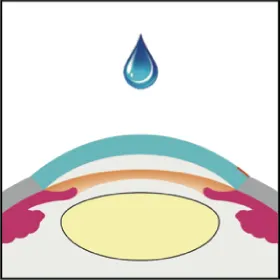 Under eye drop anesthesia, make an incision of about 3 mm in the cornea.
Under eye drop anesthesia, make an incision of about 3 mm in the cornea. -
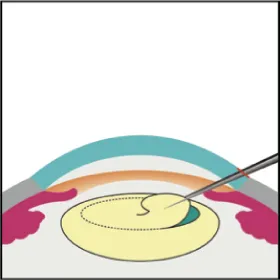 Use an instrument to cut out the anterior side of the capsular bag in a round shape.
Use an instrument to cut out the anterior side of the capsular bag in a round shape.
(This process is called anterior capsule incision) -
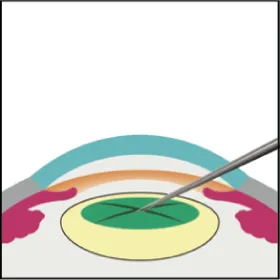 Use an instrument to divide the crystalline lens into 4 to 6 pieces.
Use an instrument to divide the crystalline lens into 4 to 6 pieces.
(This process is called lens division) -
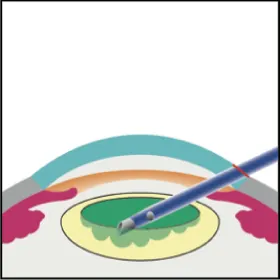 Suction while crushing the crystalline lens with ultrasonic waves.
Suction while crushing the crystalline lens with ultrasonic waves. -
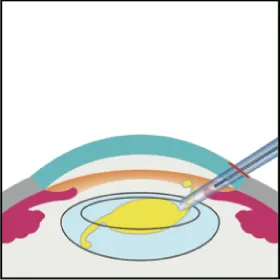 Insert the intraocular lens through the incision.
Insert the intraocular lens through the incision. -
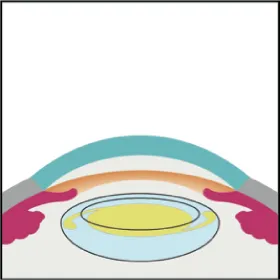 With the intraocular lens in place, the surgery is complete.
With the intraocular lens in place, the surgery is complete. -
 Rest for about 30 minutes after surgery.
Rest for about 30 minutes after surgery.
If there are no problems with the subsequent examination, you can go home.
When to undergo cataract surgery
“Cataract” is the number one cause of blindness worldwide
Age-related cataracts become cloudy around the crystalline lens, so there are no particular symptoms in the early stages. However, when the turbidity reaches the center, it also affects the eyesight. In the early stages of asymptomatic symptoms, medication can slow the progression, but it is not possible to make the cloudy lens clear, so it is important to consider surgery at the right time. The blindness rate due to cataracts in Japan is extremely low at about 3%, but the number one cause of blindness in the world is “cataracts”. In developing countries, where the spread of medical care is lagging, there are disparities in the living environment such as “no treatment”, “no hospital”, and “low medical level”, and the result of having to leave cataracts unclear is blindness.
Causes of blindness in the world
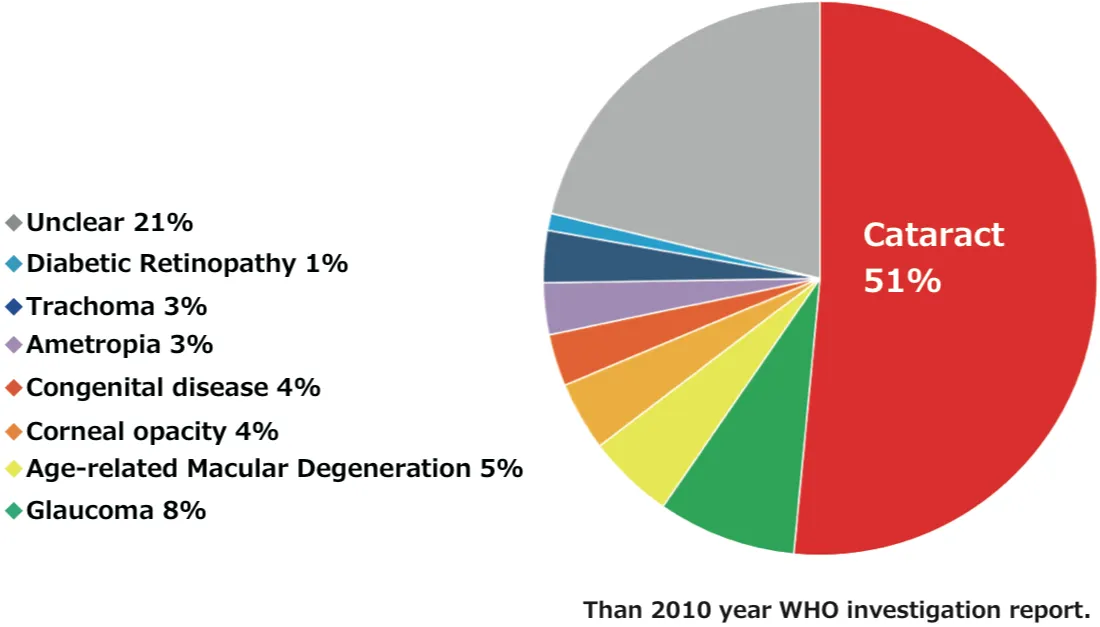
Get surgery at the right time to have surgery safely
Get surgery at the right time to have surgery safely
Age-related cataracts are said to begin in early 40s. As we get older, various aging phenomena occur, and various eye diseases other than cataracts may be found. In the early stages of cataract, eye drops can be used to slow the progression, but this also requires early detection. By undergoing regular eye examinations, you can also know the appropriate time for surgery.
If you have subjective symptoms of cataract
As cataracts progress, subjective symptoms such as blurred vision, dazzling light, and decreased vision appear. Just as there are differences in living environment and work, there are also differences in the criteria for feeling inconvenient in life, but if the symptoms of cataracts make life difficult, it is time to consider surgery. It can be said. Visit an ophthalmologist to check the condition of your eyes and discuss the appropriate time to have surgery.
What happens if you leave the cataract unattended?
Cataract is a disease that can be treated by surgery, but if left untreated, it may cause other diseases such as the following, and the risk of surgery increases significantly. In addition, it should be noted that general surgical procedures may not be possible or require hospitalization. Some people may be reluctant to have eye surgery, but if cataracts are left untreated, they can cause blindness, so it is important to have surgery at the right time in order to have surgery safely.
■Lens melting
If the cataract is left untreated and progresses until the lens becomes pure white, the lens begins to melt, causing a strong inflammation called lens-melting uveitis, resulting in red eye and severe pain. Surgery should be done immediately to prevent the inflammation from getting worse. In addition, the melted crystalline lens may flow out during surgery, which increases the difficulty of surgery and increases the frequency of complications and sequelae.■Glaucoma (acute glaucoma)
As the cataract progresses, the crystalline lens gradually expands. If the gap between the iris and the iris is blocked by the expansion of the crystalline lens, the aqueous humor circulating in the eye will not be discharged, causing glaucoma. A state of pupil block that completely blocks the space between the crystalline lens and the iris causes acute glaucoma, in which the intraocular pressure rises at once. Acute glaucoma is a very dangerous eye disease that can lead to blindness if not treated immediately.■The crystalline lens becomes hard
If the cataract is left untreated, the crystalline lens will harden. It can be handled with a certain degree of hardness, but if it becomes too hard, the difficulty of surgery and the risk of complications will increase. In some cases, normal surgical procedures may not be sufficient and the crystalline lens may have to be completely removed.Intraocular lens used for cataract surgery
The intraocular lens used in cataract surgery is about 6 mm in diameter and has a loop (support part) for fixing to the posterior capsule. There are several types of lenses: a single focus lens that focuses on one distance, a bifocal bifocal lens, a bifocal lens that supports advanced medical care, and a focus on all distances of far, middle, and near. There are three-focus lenses that fit well, and toric lenses that can correct irregular vision. Single focus lenses can only focus near or far, so you will always need glasses after surgery. Multifocal lenses focus on multiple distances, which has the effect of treating presbyopia at the same time as cataracts and reduces the frequency of eyeglasses. In recent years, the number of people who want to enjoy hobbies and sports with the naked eye is increasing, and there is a tendency for attention to multifocal lenses to increase.


